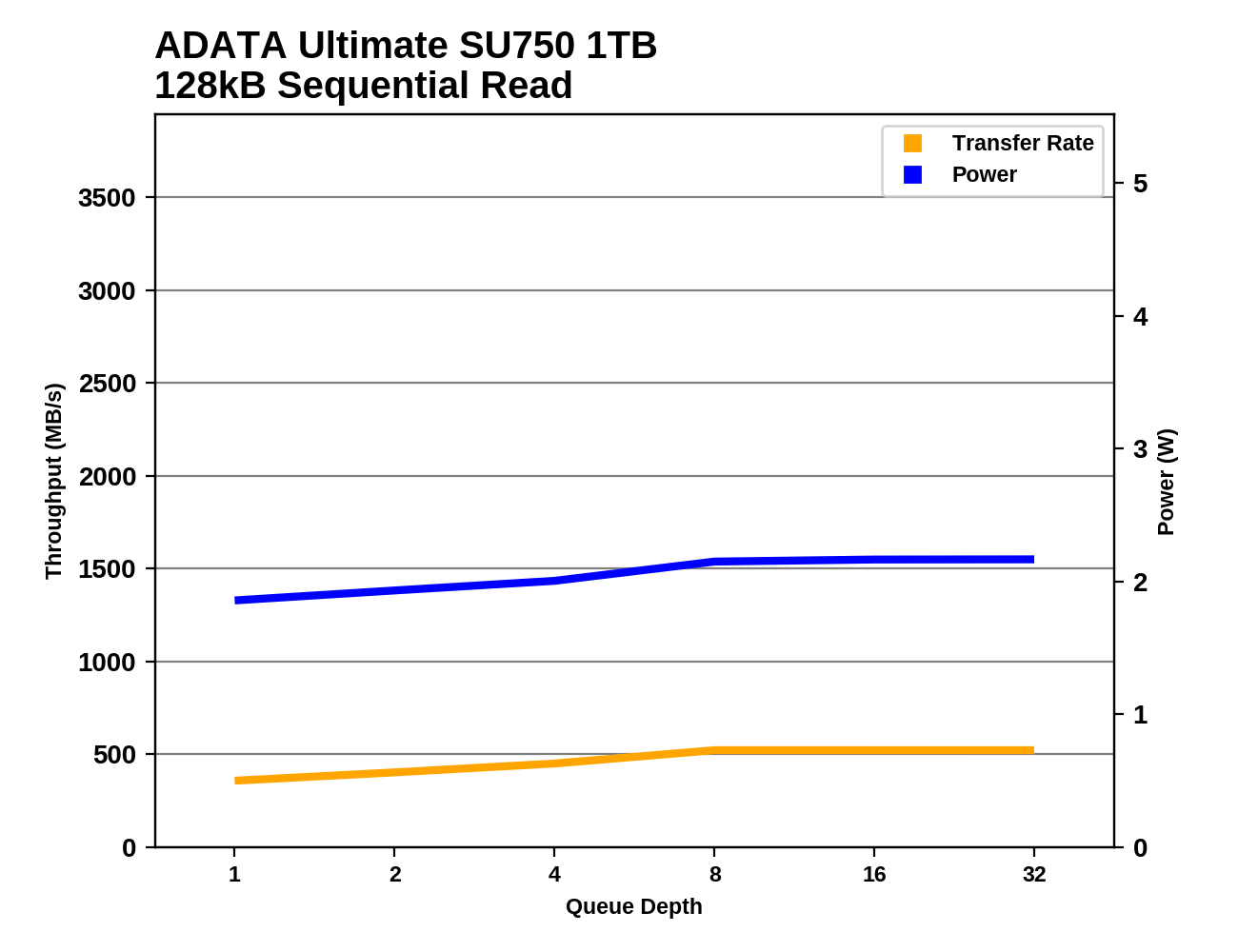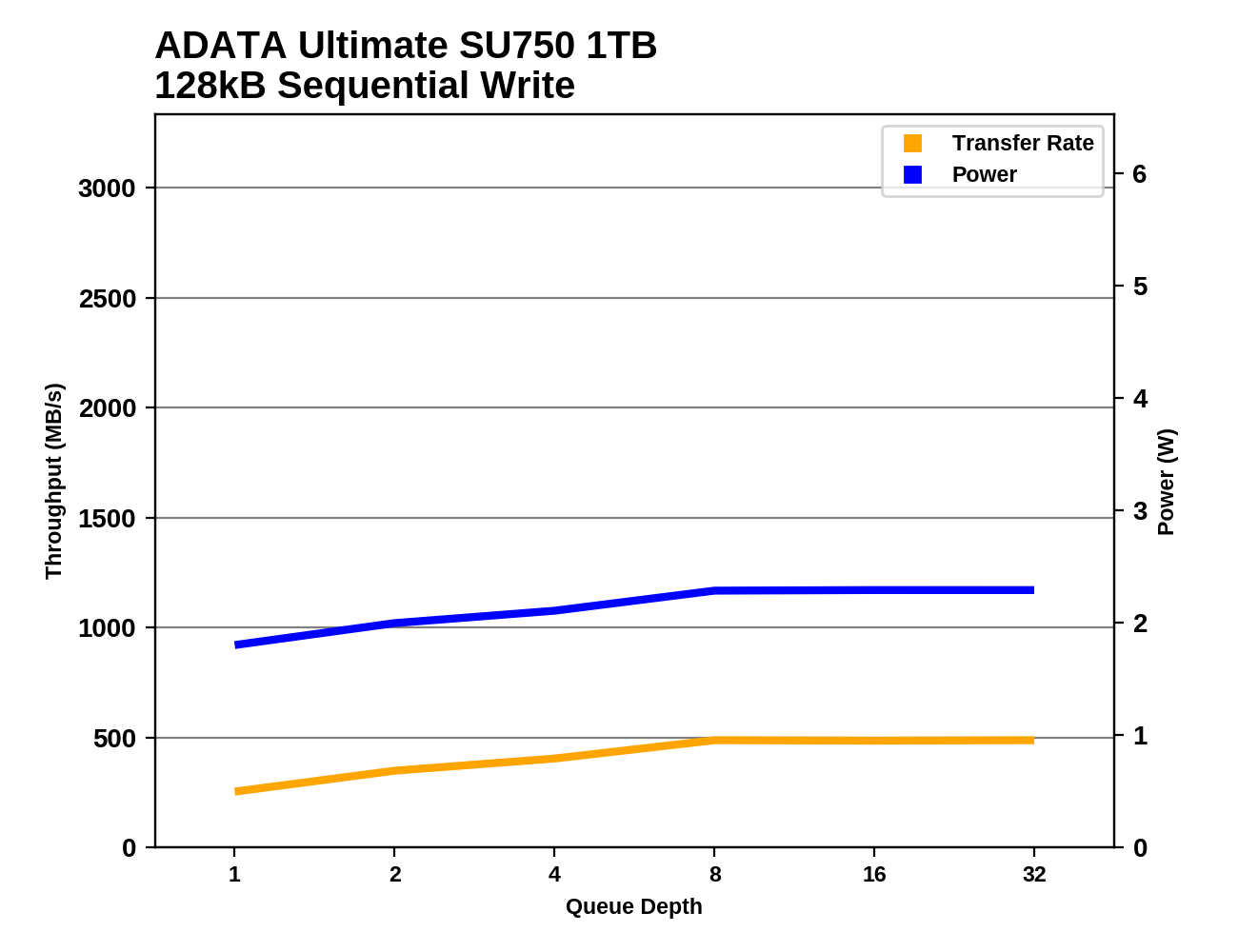The ADATA Ultimate SU750 1TB SSD Review: Realtek Does Storage, Part 1
by Billy Tallis on December 6, 2019 8:00 AM ESTSequential Read Performance
Our first test of sequential read performance uses short bursts of 128MB, issued as 128kB operations with no queuing. The test averages performance across eight bursts for a total of 1GB of data transferred from a drive containing 16GB of data. Between each burst the drive is given enough idle time to keep the overall duty cycle at 20%.

The burst sequential read performance from the ADATA Ultimate SU750 is a little bit slower than the mainstream SATA drives, but it's ahead of the other two entry-level drives.
Our test of sustained sequential reads uses queue depths from 1 to 32, with the performance and power scores computed as the average of QD1, QD2 and QD4. Each queue depth is tested for up to one minute or 32GB transferred, from a drive containing 64GB of data. This test is run twice: once with the drive prepared by sequentially writing the test data, and again after the random write test has mixed things up, causing fragmentation inside the SSD that isn't visible to the OS. These two scores represent the two extremes of how the drive would perform under real-world usage, where wear leveling and modifications to some existing data will create some internal fragmentation that degrades performance, but usually not to the extent shown here.

On the longer sequential read test, the SU750 is in last place and about 15% slower than the 860 QVO, though when reading back data that was written out of order, the 860 QVO is worse. The DRAMless Toshiba TR200 does well in both cases.
 |
|||||||||
| Power Efficiency in MB/s/W | Average Power in W | ||||||||
The power efficiency scores from the SU750 are again among the lowest, but unlike the random IO tests it isn't a big outlier in terms of either efficiency or total power draw.
 |
|||||||||
The SU750 does eventually reach sequential read speeds that more or less saturate the SATA link, but it requires a higher queue depth than any of the other drives in this batch. Power consumption is consistently just a bit higher than typical for mainstream drives, so at high queue depths its efficiency scores wouldn't be as bad as the low-QD scores shown above.
The SU750's sequential read speed at QD1 is definitely one of the slowest results we've seen, but at higher queue depths it is adequately fast and its power consumption is merely above-average and doesn't stand out from the crowd.
Sequential Write Performance
Our test of sequential write burst performance is structured identically to the sequential read burst performance test save for the direction of the data transfer. Each burst writes 128MB as 128kB operations issued at QD1, for a total of 1GB of data written to a drive containing 16GB of data.

The burst sequential write performance of the SU750 is clearly slower than mainstream SATA drives, but is nowhere near as bad as the Toshiba TR200's sub-HDD result.
Our test of sustained sequential writes is structured identically to our sustained sequential read test, save for the direction of the data transfers. Queue depths range from 1 to 32 and each queue depth is tested for up to one minute or 32GB, followed by up to one minute of idle time for the drive to cool off and perform garbage collection. The test is confined to a 64GB span of the drive.

On the longer sequential write test that brings in some higher queue depths, the SU750 falls a little further behind the mainstream SATA drives, and the Samsung 860 QVO crashes down to last place while the Toshiba TR200 starts to catch up with the SU750.
 |
|||||||||
| Power Efficiency in MB/s/W | Average Power in W | ||||||||
The power efficiency score for the SU750 during the sequential write test is not bad, for a change. The absolute power consumption is lower than most of the other drives, and the performance is good enough to make for decent efficiency.
 |
|||||||||
As with the sequential read test, the SU750 needs a fairly high queue depth to reach its full sequential write performance, which is competitive with mainstream SATA drives. It retains that performance for the rest of the test.
The low-QD sequential write performance from the SU750 could certainly be a lot worse, judging by some of the results from our archive. Across its entire speed range, the power consumption of the SU750 seems to be a bit below average, but never low enough to translate into impressive efficiency.












54 Comments
View All Comments
Samus - Sunday, December 8, 2019 - link
I didn't even want to bring up Killer XDdeil - Monday, December 9, 2019 - link
Well ONLY cards where I lost sound due to broken drivers is realteck. AND coincidentally ONLY network adapter that was supposed to do full gigabit, and stopped negotiation at 10 mbps was also realteck.they can do decent hardware, but soft from them is crappiest as possible.
HollyDOL - Saturday, December 7, 2019 - link
My 1st hand experience with Realtek dates back to Pentium 4 era. And it was so bad then I am still avoiding anything done by them in almost panic mode. Maybe they improved since then, but I am still not in state of mind to spend few $ to try.Gigaplex - Saturday, December 7, 2019 - link
Intel was terrible in the Pentium 4 era. Do you also avoid Intel in the same way?HollyDOL - Saturday, December 7, 2019 - link
Intel never had problems with functionality or output quality. For many scenarios you had better perf/$ on Athlons, but you didn't have problems having multiple computers on same network with Intel NIC having same MAC, lousy sound quality infested with noise or very low NIC performance.So no, I am not avoiding Intel same way since I never had remotely similar problems with them.
close - Saturday, December 7, 2019 - link
They weren't that bad. After building a neighborhood network (100Mbps and constantly saturated with Direct Connect P2P transfers) with thousands of clients (perhaps in the 5 figures or close to), 99.9% being Realtek network chipsets I'd say many of the issues are a bit overstated. Sure Intel was (is?) better but other than crappy support in Linux at that time, there was nothing out of the ordinary bad with Realtek. Not one MAC issue, not very low performance.I'm sure those thousands are not representative of all Realtek sales but I think there must also be some bias in there where the multitude of reports on forums makes you think it's an absolute rule that they were crap. Sound cards... dunno, had them on many PCs but rarely cared about the sound back in the day.
Samus - Sunday, December 8, 2019 - link
Terrible performance maybe. But Intel has always been fairly reliable. They've had a few minor chipset recalls, and the embarrassing, but very limited Pentium III recall, but on the whole they have traditionally had less errata than AMD and quite frankly their chipsets were always the gold-standard of PC's. Their network controllers are among the best in the world.PeachNCream - Friday, December 6, 2019 - link
ADATA has gotta get out of this town, out of this town and out of L.A. - with those prices. TRIM them to around $80 for 1TB and they will have a Solid pricing State to Drive sustained sales.bananaforscale - Friday, December 6, 2019 - link
Realtek does Dallas Semi?Lord of the Bored - Friday, December 6, 2019 - link
No, Maxim did Dallas Semiconduotor.